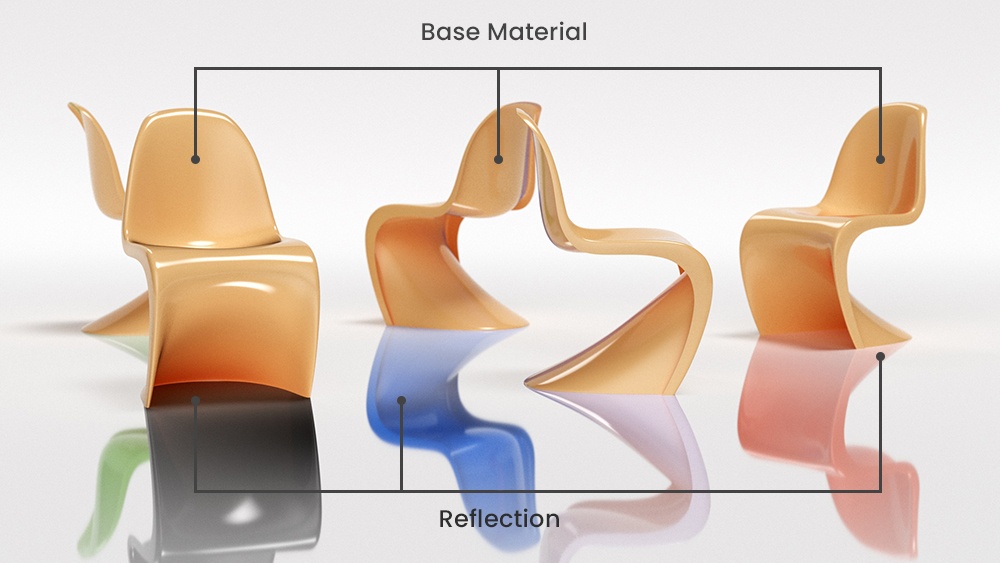Page History
...
| Section | |||||||||||||||
|---|---|---|---|---|---|---|---|---|---|---|---|---|---|---|---|
|
...
This example shows how the use of a GI material affects the rendering.
| Section | ||||||||||||||||||||||||||||||||||||||||||||
|---|---|---|---|---|---|---|---|---|---|---|---|---|---|---|---|---|---|---|---|---|---|---|---|---|---|---|---|---|---|---|---|---|---|---|---|---|---|---|---|---|---|---|---|---|
|
As
you can see, the This simple interior scene represents a square-type room. There are window openings in one of the wall. There is a Direct Light coming through, which simulates the Sun. The floor has a texture in the Diffuse map slot. All the rest - the walls, the ceiling and the teapots have a Default VRayMtl with a Diffuse Color (200, 200, 200).room lit by two rectangle VRayLights - one hidden top light and another back fill light - as well as by three disc VRayLights for the pendant lamps above the sinks.
A wooden VRayMtl from the Chaos Cosmos library is applied on the floor, and a default VRayMtl with Diffuse color (128, 128, 128) is applied on the rest of the scene objects, except for the glass objects (mirror and pendant lamp plafonds).
In the first image, it is visible that all walls, objects, and the ceiling are rendered in some light brown color, despite having On the first render, it is absolutely visible that all the walls, the ceiling, and the teapots have been rendered in some light brown (pale pumpkin) color, although they have a light-gray material assigned to them. This is because of the Color Bleeding, which is generated by the GI calculation.due to the color bleeding, generated by the GI calculations.
In the second imageOn the second picture, the scene is rendered with a VRayOverride a VRayOverride GI material assigned material assigned to the Floor.This material floor. The VRayOverrideMtl contains in itself the initial 2 two V-Ray materials - the floor's and the walls' ones. So now assigned on the floor object, : the wooden VRayMtl as base and the default VRayMtl as GI material. The rest of the scene objects keep the default gray VRayMtl. So now V-Ray knows that while calculating the GI it the GI it has to use the GI material the GI material (in our this case: walls - VRayMtl with Diffuse Color (200, 200, 200)VRayMtl with Diffuse color (128, 128, 128) and during rendering it uses the Base material the Base material (in our this case: floor - VrayMtl with texture in the Diffuse Slotthe wooden VRayMtl). The The result of that is quite different from the previous render as the Color Bleeding has is gone. Of Of course this depends entirely on our your choice for the GI material. For instance, if we you had chosen a bluish colored material, the final result would also be tinted slightly to blue, like in the first render with the pale brown colors.In this simple scene, the result of the second render can be produced, with a pre-saved irradiance map, calculated with just the walls' material assigned to all the geometry.
For a much more complex scene, with lots of different geometry, shaders, textures, etc., using the VRayOverride material can be very helpful.
...
Example: Using the Reflect material
The scene used in the following examples is very simple and contains four boxes five chairs and a light source in a studio type environment. Each box chair has a VRayOverride material assigned, but only the Base material is active. The rendered boxes have identical diffuse The rendered chairs are the same in their diffuse colors and reflections.
...
| Section | |||||||||||||||
|---|---|---|---|---|---|---|---|---|---|---|---|---|---|---|---|
|
As you can see now, Now each of the boxes chairs has a different material assigned in their VRayOverride Reflect material. The first one has a red green diffuse color, the middle two have green, and second one has black, the third one has blue, the fourth - purple, and the fifth has a red diffuse color. V-Ray uses those materials when the objects are seen in reflections. In our scene, both the ground and base material for the boxes are reflective surfaces. Notice that the green reflections from the middle cubes are visible on the right cube as well.
...
this scene, the environment is actually a reflective surface, so the chairs are being reflected. On the other hand, you can also notice that the base material of the chairs is also reflective, and the fourth chair is seen with its Override Reflect material in the middle chair.
| Section | |||||||||||||||
|---|---|---|---|---|---|---|---|---|---|---|---|---|---|---|---|
|
| Anchor | ||||
|---|---|---|---|---|
|
...
Example: Using the Refract material
The next render is slightly even more complex and includes two thin glass boxes in the foreground. The VRayOverride Refract material is activated, and each box has a different refract material (diffuse cyan, yellow, and magenta) assigned. V-Ray uses these materials when the material is viewed through a refractive surface such as the glass.as the chairs' Override Refract material is activated as well. From left to right follow: a blue and a red diffuse color. Those materials are set so that when seen through refraction, V-Ray considers and renders the objects with them. As you can see the Reflect materials are still affecting the render image.
If you take a Note the Reflect materials are still enabled and affecting the render image. A closer look at the glass chairs' edges will show red and blue reflections from the left and right boxesyou will notice the green reflection, which is actually the reflect material of the right chair. While V-Ray had been tracing the rays on the glass chairs' surfaces, those polygons on the edges had first captured a reflection, hence the traces of red and blue.
so that's why there are green traces.
| Section | ||||||||||||||
|---|---|---|---|---|---|---|---|---|---|---|---|---|---|---|
|
...
|
Notes
...
| Fancy Bullets | ||
|---|---|---|
| ||
|






